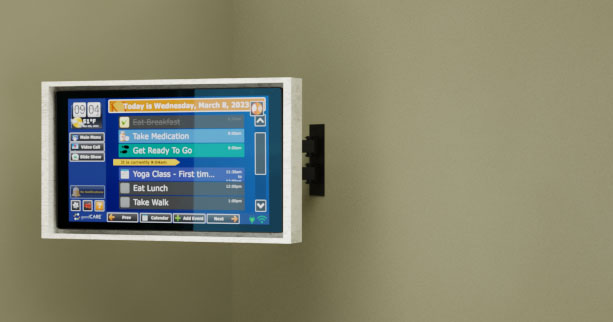CE Pro: Why Home Health Technology Will Explode in 2011
In the January 2011 issue, the editors of CE Pro feature the Five Technology Opportunities for CE Pros. Once again, aging in place/home health technology made the list at number three and GrandCare is featured front and center as the industry leader. Here is what Julie Jacobson – a recent guest speaker on GrandCare’s weekly webinar – writes:
We’ve hailed the coming of home health technology for several years now, but we really believe CE pros will embrace the market in 2011 and beyond. That’s when we reach a critical point in terms of the aging population, financially burdened healthcare system, and emergence of exciting technologies for seniors and their caretakers.
That’s also when many CE pros will have exhausted their growth options in traditional home systems integration.
The opportunities in the health technology sector are plentiful as are the terms you may hear to describe them: telehealth, telemedicine, telewellness, connected health, e-health, mHealth (as in mobile), aging in place, digital health and more.
They also encompass a number of technologies and markets, so it is difficult to pin down the numbers. At the very least, all of the players agree that the market – whatever you call it – is growing. Research firm InMedica predicts that the “telehealth” market will grow 55 percent (CAGR) per year in the next five years.
Of the disparate health technology sectors, CE Pro believes the best opportunity for residential integrators is to stick with their core competencies: security, home control and communications.
The bustling health tech pavilions last year at the Electronic House Expo and CEDIA Expo provided a good overview of the opportunities for integrators:
Whole-house care: Monitoring seniors via sensors, and sending alerts to loved ones and caretakers.
Communications: Establishing videoconferencing, email and telecommunications between the client and family, friends and health professionals.
Environment: Creating well-lit, appropriately cooled/heated, safe and secure, and otherwise comfortable environments for the elderly.
In the Field
Cybermation, based in Waite Park, Minn., is a typical home systems integration firm. Like many CE pros, the company thrived during the home construction boom and continues to enjoy a strong relationship with homebuilders, but that doesn’t help these days.
In his quest to find new markets for Cybermation’s mid- to high-end integration services, CEO Tom Ardolf explored commercial installations, as well as mass-market opportunities. In the end, he decided to address the aging population, and he is nowdoing that with systems from Grandcare that provide monitoring, communications and messaging for the elderly.
Deciding on a product line was the easy part for Cybermation, as it is for many integrators exploring the seniors market. The hard part is learning the industry protocol and finding customers and partners, including third-party payers.
“I spent months trying to figure out how home healthcare agencies work,” Ardolf says. “There’s a humongous government bureaucracy. It’s tricky trying to figure out who the gatekeepers are.”
The effort is paying off. Cybermation has tapped funds and grants from private and county agencies, and the company is working with a local home healthcare agency (HCA) to offer Grandcare solutions to seniors.
Currently, the HCA offers Grandcare free of charge to prospects as a way of attracting new business for its home health services. Cybermation installs the system (paid for by the various grants) for 60 to 90 days. If the client decides to keep the system, they pay only the $50/month fee for system hosting and software maintenance (through Grandcare). Otherwise, Cybermation removes the system so it can be offered to another prospect.
The outlay for the “free” install is nominal, Ardolf says. Currently, Cybermation budgets about one hour of labor for setting up a basic Grandcare system, plus 45 minutes per wireless sensor, but that estimate is extremely conservative.
Work with the one HCA has given Cybermation the confidence and the resolve to invest more heavily in the seniors market. Ardolf is calling all of the local HCAs – for profit and not-for-profit – and educating them about new and forthcoming technologies for seniors.
The word is getting out, and Cybermation has sold a few jobs. A basic system that monitors and responds to “activities for daily living,” or ADL, sells for about $3,000. A blood pressure cuff is included. From there, Cybermation can add touchscreen stations for social and medical interactions, and a host of other medical devices and environmental sensors.
Why Home Health Tech is Hot
Demographics, demographics, demographics. Your customers are growing older … and so are their parents.
CE pros already master most of the technologies demanded by seniors and their caretakers – security, lighting and temperature control, audio, video, communications and remote monitoring, to name a few. Even without learning new technological tricks, you’re ready to go.
The aging in place industry has no other suitable channel for bringing technology into the homes and lives of seniors. They are starting to realize the value of CE pros.
While there is work to be done, reimbursement rates for home health technology are on the rise from both private and government insurers, spurred by the overburdened healthcare system. Grants from various agencies also are available. For reimbursement resources visit click here.
Recurring revenue opportunities abound.
This post was originally written by Home Controls, an authorized GrandCare Distributor: To learn more about how GrandCare can benefit your family, contact Home Controls at 800-266-8765 to find a local authorized dealer near you.







